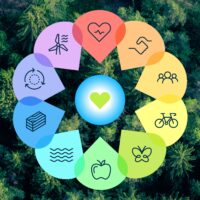Six simple features of circular economy business models explained
What are circular economy business models?
As humans, we like simplicity – so we like neat solutions to problems. This is probably why it’s appealing to define the circular economy simply as closed-loop production, as many seem to do.
If you’re new to the concept of ‘closing the loop’, I define it as collecting post-consumer waste, recycling it and turning it back into the same product (or if we are being less pure then turning it into something new).
But while closing the loop plays a critical role in the circular economy story, the two concepts shouldn’t be conflated. Thinking of it solely in these terms misses out the truly transformative potential of circular thinking.
To understand the full potential of the circular economy I reviewed a wide range of useful circular economy business model frameworks and tools, including those created by Forum for the Future, WRAP and Accenture. I also reviewed the draft BSI circular Economy Standard.
Across all these versions I identified six simple features of circular businesses which are presented in the matrix below. These are grouped into three categories: features that relate to processes, features that relate to product-life extension, and finally features that relate to service models.
To make your business circular you will need at least one of the features outlined below; although bear in mind that the presence of any one feature on its own is by no means a guarantee that your business is now circular.
From my perspective, it is a misnomer to suggest there is such a thing as a “circular economy" business model that you can just take off a shelf, apply to your business, and hey presto – suddenly your business is “circular”. It is more the case that through increasing your circular thinking and understanding, you can correctly apply one or more of the features outlined below to make your business more circular. I would also argue that for an incumbent business, this is going to be an iterative process, starting with small pilot projects to test out ideas and then moving onto more fundamental rethinking of the entire business purpose and operating model.
Six simple features of circular economy business models
Six simple features of circular businesses. These are grouped into three categories: features that relate to processes, product-life extension, and service models
Download PDFI hope this matrix shows that closing the loop is by no means the Holy Grail of the circular economy. Taking such a narrow perspective on the circular economy, focused solely resource efficiency and designing out waste, is clearly not going to address the major sustainability problems that we face.
Circular thinking could completely change the way we work, consume and even travel, and in my opinion has the potential to enable us to live happier, healthier lives within the means of our one planet
When we take into account all the different dimensions of circular economy business models we begin to see just how transformative it could be – from totally rethinking the design process, to enabling fairer access to products and services through collaborative consumption.
Circular thinking could completely change the way we work, consume and even travel, and in my opinion has the potential to enable us to live happier, healthier lives within the means of our one planet. However, for businesses, governments and others to maximise the potential of circular thinking we need to ensure we are taking into account all the dimensions outlined above.
This may sound daunting, but it doesn’t have to be. Download our guide to the circular economy below or learn more about our circular economy services.
The circular economy: cracking the challenge
The circular economy is one of the biggest challenges - yet most exciting opportunities - for today's businesses. This guide will help your business get started, and explain the benefits of embracing the circular economy
Download PDF








